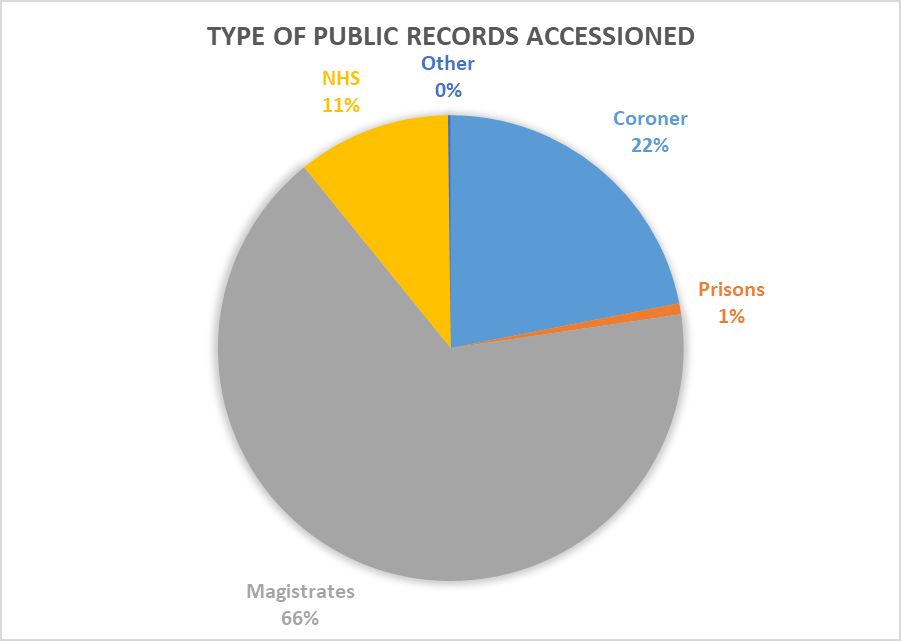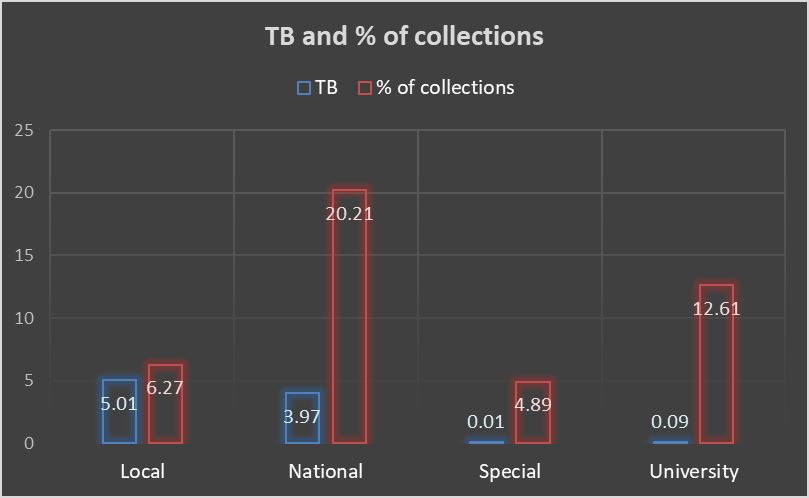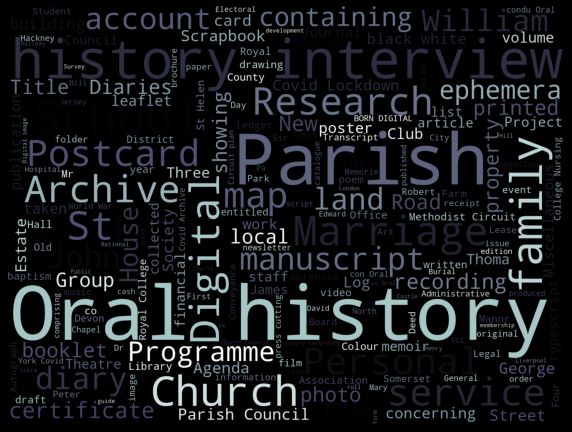Main section
Image above: taken at a Black Lives Matter protest, Jersey.
Image credit: Melissa Rodrigues, Jersey Heritage staff member
Click on the headings below to read our analysis of the 2020 Accessions to Repositories survey data:
Tabs Navigation
Tabs
Public records
New Burdens funding
2020 saw a considerable drop in the number of archives accessioning public records. Only 37 places of deposit (PoDs) accessioned records eligible for New Burdens funding, with an average amount of 15.62 linear metres (lm) per PoD. This funding is to help local authorities cover the costs of taking in records faster as the 30-year rule for transferring records is gradually changing into the 20-year rule. In contrast, between 2015 and 2019, 49 PoDs on average each accessioned 30 linear metres of eligible public records per year. Last year, the total of eligible public records accessioned amounted to 577.86 lm, which is the lowest accession rate of public records since 2015, and resulted in a pay out of £1142.13 per lm.
Lancashire Archives accessioned the largest collection of public records – just over 103 lm of magistrate court registers – and also accessioned the most public records overall at 119.01 lm. Kent History and Library Centre accessioned 62.9 lm and Gloucestershire Archives took in 48.67 lm of public records. As a result, Lancashire Archives received funds of £135,924.89, Kent History and Library Centre received £78,692.76 and Gloucestershire Archives received £55,587.47.
Magistrates and coroners court records accounted for the largest public record collections accessioned, though collections of NHS trust and hospital records were also fairly substantial. Prison records represented the smallest type of public records transferred to archives in 2020. No digital public records accessioned were eligible for New Burdens funding.
Number of Places of Deposit eligible for New Burdens funding
2015: 47
2016: 60
2017: 47
2018: 43
2019: 50
2020:37
Total eligible public records accessioned
2015: 1094.13 linear metres (23.27 lm on average per PoD)
2016: 2088.24 linear metres (34.8 lm on average per PoD)
2017: 809.24 linear metres (17.35 lm on average per PoD)
2018: 1091.64 linear metres (25.38 lm on average per PoD)
2019: 2484.81 linear metres (50.67 lm on average per PoD)
2020: 577.86 linear meters (15.62 lm on average per PoD)
New Burdens payment per linear metre
2015: £603.21
2016: £316.05
2017: £815.58
2018: £604.59
2019: £265.62
2020: £1142.13
Return to Part 1: Introduction
Continue to Part 3: New in archives
Digital accessions
Digital records accessioned in 2020 form a considerably greater proportion of collections than has been the case in previous years. However, this appears to be a consequence of the reduction in physical collections accessioned because of the COVID-19 pandemic, rather than a significant increase in the total volume of digital records. In 2019, archives accessioned over 13 terabytes (TB) across 352 digital collections, which made up 2.46% of all reported collections. Last year, the figure was just over 9TB across 643 collections, representing 8.67% of the 7415 collections reported in the accessions survey. The largest digital accession was 1625GB – compared with 4TB in 2019. The 1625GB consisted of material selected and digitised by Greater Manchester County Record Office for the Spinning the Web website, a project publishing the history of mills across the Manchester area over the internet. Overall, there were more digital collections of smaller volume, but also significantly fewer physical records, accessioned in 2020.
National and local repositories accessioned the largest digital collections, both in terms of single accessions and overall volume. But while these made up 20.2% of national collections, digital records made up only 6.3% of reported local archives’ collections. For university archives, the volume of digital objects collected was relatively small in 2020, but made up 12.6% of their reported accessions. In specialist repositories, digital records represented only 4.98% of their new collections. These differences in the volume and percentage of digital records accessioned across different types of archive have remained relatively consistent for the past couple of years.
Overall digital collections accessioned
2016: 0.11 terabytes (0.22% of all collections accessioned)
2017: 18.2 terabytes (1.8% of all collections accessioned)
2018: 8.3 terabytes (3.6% of all collections accessioned)
2019: 13.4 terabytes (2.46% of all collections accessioned)
2020: 9.01 terabytes (8.67% of all collections accessioned)
Return to Part 1: Introduction
Continue to Part 3: New in archives
Keywords
The pandemic caused significant disruption in the archive sector, but keywords from the descriptions of 2020 accessions suggest that collecting and descriptive practices have continued to be sustainably stable. Documents related to the major institutions of church, school and council remain the most frequent types of records accessioned. We can see a significantly greater emphasis on oral histories than previous years. This may have stemmed from archive services seeking to document initial reactions to the pandemic, but otherwise much remains the same.
A similar picture emerges when we consider the ratio of male and female pronouns used to describe record creators. The split follows the same trend seen in previous years with approximately 70% male and 30% female pronouns reflected in the data.
Word frequency
Church: 584
Court: 546
School: 534
St: 511
History: 477
Parish: 388
Council: 352
John: 344
Family: 343
Service: 337
Rail: 285
Street: 72
2020: 271
Road: 257
Hall: 245
Plan: 243
Project: 235
House: 234
Oral: 228
Return to Part 1: Introduction
Continue to Part 3: New in archives
Impact of COVID-19
Archives continued to collect new material throughout the pandemic, including records that reflected the initial responses and reactions to COVID-19. Suffolk Record Office collected material, including diaries, photos and posters, for the ‘Recording Life in Lockdown’ project. Northumberland archives created oral history recordings of council and archive staff talking about their experiences during the early phases of the pandemic. Tower Hamlets Local History Library and Archives gathered material from local residents to document COVID-19 in the East End.
However, it is also clear that the pandemic caused considerable disruption to the sector. Overall, the number of reported collections was just over half of the usual volume. Fewer archives were able to respond to the survey at all. Last year saw a 9% decline in the number of respondents, and over 40% reduction in the volume of collections reported. This was also reflected in the number of public records accessioned and those eligible for New Burdens funding.
Nevertheless, 2020 also saw a number of archives responding to the survey for the first time. The restrictions following the pandemic provided a good opportunity to get collections online and interact with researchers through a digital medium.
We are yet to see the full effects of the pandemic and subsequent lockdowns/restrictions. Many of the effects are ongoing and it is difficult to see the directions they will ultimately take. The past year has shown that we can be confident the sector will rise to the challenge, continue to collect material of evidential and cultural value, whether in digital or physical format, and actively engage with local communities and researchers.

This image is part of a larger collection of photographs and placards deposited in Jersey Archives. These document a Black Lives Matter protest that took place in the wake of George Floyd’s murder. This was a local gesture of solidarity with a cause that began on the other side of the world. It helps to underline the international and connected nature of popular movements and causes. The protest took place at the beginning of the coronavirus pandemic as masks and social distancing were starting to become part of everyday life. This can be seen in the photographs.


